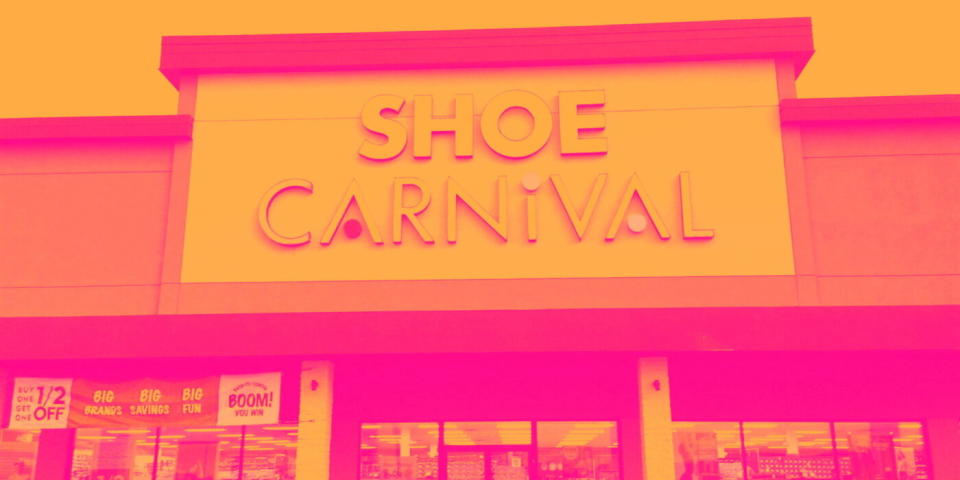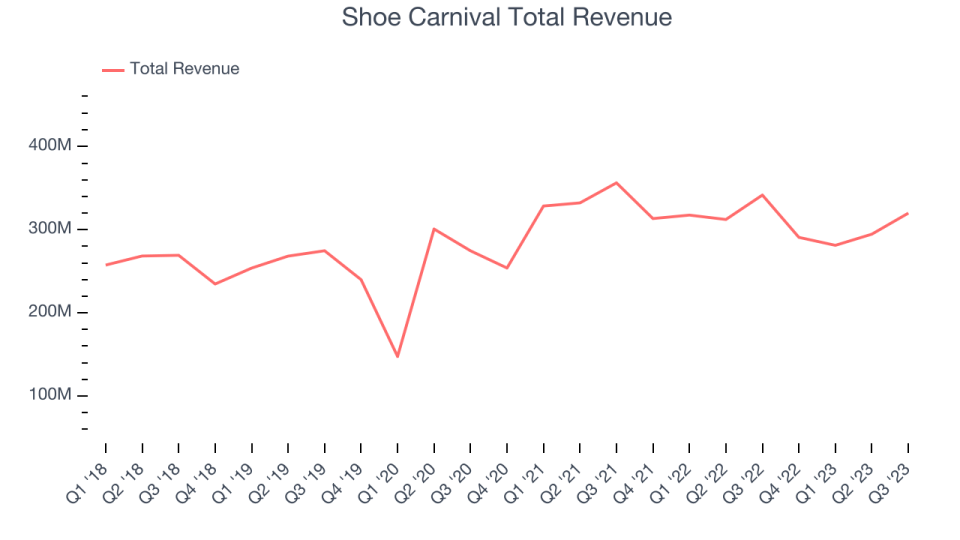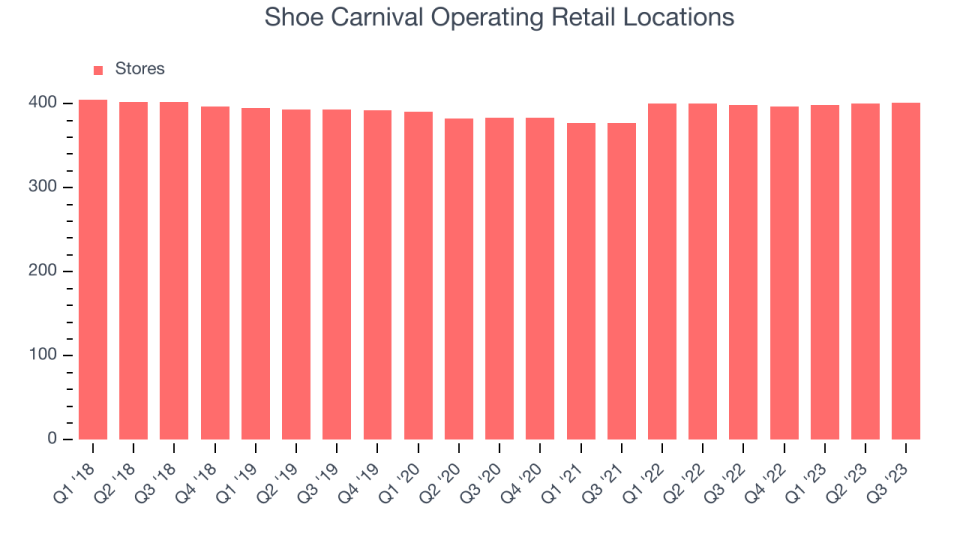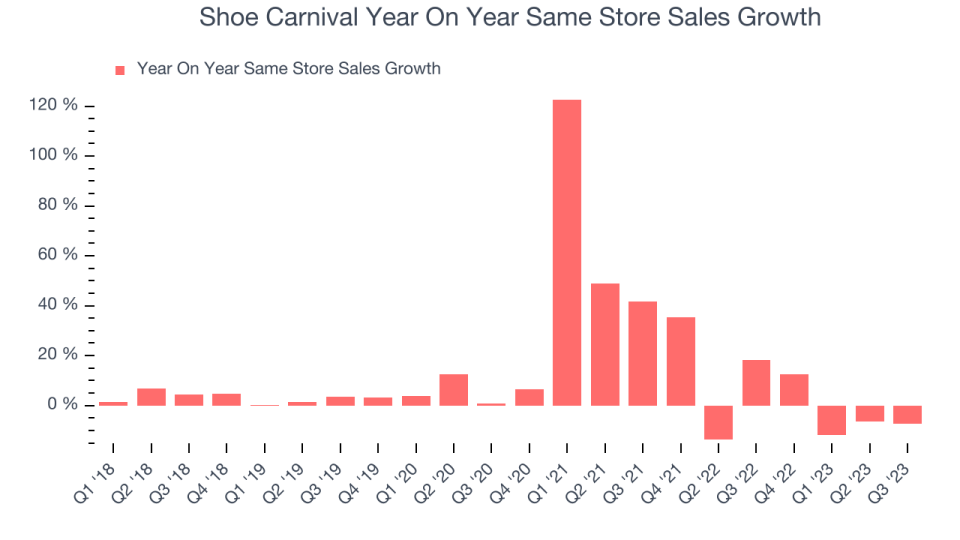Shoe Carnival (NASDAQ:SCVL) Misses Q3 Revenue Estimates

Footwear retailer Shoe Carnival (NASDAQ:SCVL) reported results in line with analysts' expectations in Q3 FY2023, with revenue down 6.4% year on year to $319.9 million. On the other hand, its full-year revenue guidance of $1.17 billion at the midpoint came in 1.3% below analysts' estimates. Turning to EPS, Shoe Carnival made a GAAP profit of $0.80 per share, down from its profit of $1.18 per share in the same quarter last year.
Is now the time to buy Shoe Carnival? Find out by accessing our full research report, it's free.
Shoe Carnival (SCVL) Q3 FY2023 Highlights:
Revenue: $319.9 million vs analyst estimates of $321.3 million (small miss)
EPS: $0.80 vs analyst expectations of $0.95 (15.3% miss)
The company dropped its revenue guidance for the full year from $1.2 billion to $1.17 billion at the midpoint, a 2.5% decrease
Free Cash Flow of $34.03 million is up from -$3.42 million in the same quarter last year
Gross Margin (GAAP): 36.8%, down from 38.3% in the same quarter last year
Same-Store Sales were down 7.4% year on year (miss vs. expectations of down 6.4% year on year)
Store Locations: 401 at quarter end, increasing by 3 over the last 12 months
“Our team delivered a successful Back-to-School season, with solid growth in the children’s business, double-digit Shoe Station banner growth and continued market share gains in the family footwear channel. After Labor Day, Shoe Carnival banner results softened and were below our expectations, as persistently hot and dry weather led to soft seasonal sales and a sluggish start to the boot season,” said Mark Worden, President and Chief Executive Officer.
Known for its playful atmosphere that features carnival elements, Shoe Carnival (NASDAQ:SCVL) is a retailer that sells footwear from mainstream brands for the entire family.
Footwear Retailer
Footwear sales–like their apparel counterparts–are driven by seasons, trends, and innovation more so than absolute need and similarly face the bigger-picture secular trend of e-commerce penetration. Footwear plays a part in societal belonging, personal expression, and occasion, and retailers selling shoes recognize this. Therefore, they aim to balance selection, competitive prices, and the latest trends to attract consumers. Unlike their apparel counterparts, footwear retailers most sell popular third-party brands (as opposed to their own exclusive brands), which could mean less exclusivity of product but more nimbleness to pivot to what’s hot.
Sales Growth
Shoe Carnival is a small retailer, which sometimes brings disadvantages compared to larger competitors that benefit from economies of scale.
As you can see below, the company's annualized revenue growth rate of 3.6% over the last four years (we compare to 2019 to normalize for COVID-19 impacts) was mediocre , but to its credit, it opened new stores and grew sales at existing, established stores.

This quarter, Shoe Carnival reported a rather uninspiring 6.4% year-on-year revenue decline, missing Wall Street's expectations.
While most things went back to how they were before the pandemic, a few consumer habits fundamentally changed. One founder-led company is benefiting massively from this shift and is set to beat the market for years to come. The business has grown astonishingly fast, with 40%+ free cash flow margins, and its fundamentals are undoubtedly best-in-class. Still, its total addressable market is so big that the company has room to grow many times in size. You can find it on our platform for free.
Number of Stores
A retailer's store count often determines on how much revenue it can generate.
When a retailer like Shoe Carnival keeps its store footprint steady, it usually means that demand is stable and it's focused on improving operational efficiency to increase profitability. As of the most recently reported quarter, Shoe Carnival operated 401 total retail locations, in line with its store count a year ago.

Over the last two years, the company has only opened a few new stores, averaging 2.4% annual growth in new locations. This sluggish pace lags the broader sector. A flat store base means that revenue growth must come from increased e-commerce sales or higher foot traffic and sales per customer at existing stores.
Same-Store Sales
Same-store sales growth is a key performance indicator used to measure organic growth and demand for retailers.
Shoe Carnival's demand within its existing stores has generally risen over the last two years but lagged behind the broader consumer retail sector. On average, the company's same-store sales have grown by 3.8% year on year. With positive same-store sales growth amid an increasing physical footprint of stores, Shoe Carnival is reaching more customers and growing sales.

In the latest quarter, Shoe Carnival's same-store sales fell 7.4% year on year. This decline was a reversal from the 18.3% year-on-year increase it posted 12 months ago. We'll be keeping a close eye on the company to see if this turns into a longer-term trend.
Key Takeaways from Shoe Carnival's Q3 Results
Sporting a market capitalization of $661.3 million, Shoe Carnival is among smaller companies, but its more than $71.12 million in cash on hand and positive free cash flow over the last 12 months puts it in an attractive position to invest in growth.
We struggled to find many strong positives in these results. Its full-year earnings forecast underwhelmed and it missed on key items like same-store sales, revenue, and EPS. Overall, this was a mediocre quarter for Shoe Carnival. The stock is flat after reporting and currently trades at $24.17 per share.
Shoe Carnival may have had a tough quarter, but does that actually create an opportunity to invest right now? When making that decision, it's important to consider its valuation, business qualities, as well as what has happened in the latest quarter. We cover that in our actionable full research report which you can read here, it's free.
One way to find opportunities in the market is to watch for generational shifts in the economy. Almost every company is slowly finding itself becoming a technology company and facing cybersecurity risks and as a result, the demand for cloud-native cybersecurity is skyrocketing. This company is leading a massive technological shift in the industry and with revenue growth of 50% year on year and best-in-class SaaS metrics it should definitely be on your radar.
Join Paid Stock Investor Research
Help us make StockStory more helpful to investors like yourself. Join our paid user research session and receive a $50 Amazon gift card for your opinions. Sign up here.
The author has no position in any of the stocks mentioned in this report.
